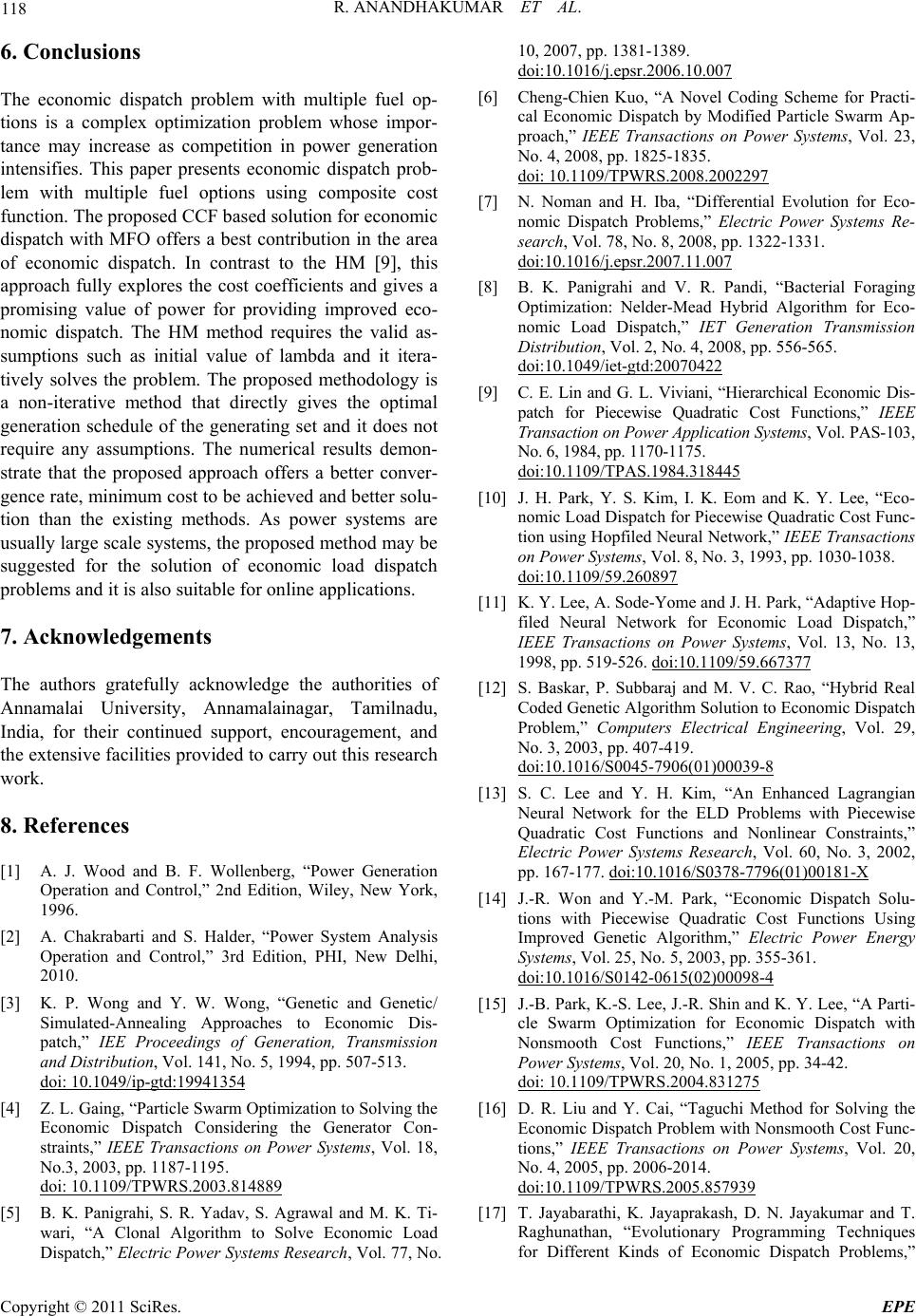
R. ANANDHAKUMAR ET AL.
Copyright © 2011 SciRes. EPE
118
6. Conclusions
The economic dispatch problem with multiple fuel op-
tions is a complex optimization problem whose impor-
tance may increase as competition in power generation
intensifies. This paper presents economic dispatch prob-
lem with multiple fuel options using composite cost
function. The proposed CCF based solution for economic
dispatch with MFO offers a best contribution in the area
of economic dispatch. In contrast to the HM [9], this
approach fully explores the cost coefficients and gives a
promising value of power for providing improved eco-
nomic dispatch. The HM method requires the valid as-
sumptions such as initial value of lambda and it itera-
tively solves the problem. The proposed methodology is
a non-iterative method that directly gives the optimal
generation schedule of the generating set and it does not
require any assumptions. The numerical results demon-
strate that the proposed approach offers a better conver-
gence rate, minimum cost to be achieved and better solu-
tion than the existing methods. As power systems are
usually large scale systems, the proposed meth od may be
suggested for the solution of economic load dispatch
problems and it is also suitable for online applicatio ns.
7. Acknowledgements
The authors gratefully acknowledge the authorities of
Annamalai University, Annamalainagar, Tamilnadu,
India, for their continued support, encouragement, and
the extensive facilities prov ided to carry out this research
work.
8. References
[1] A. J. Wood and B. F. Wollenberg, “Power Generation
Operation and Control,” 2nd Edition, Wiley, New York,
1996.
[2] A. Chakrabarti and S. Halder, “Power System Analysis
Operation and Control,” 3rd Edition, PHI, New Delhi,
2010.
[3] K. P. Wong and Y. W. Wong, “Genetic and Genetic/
Simulated-Annealing Approaches to Economic Dis-
patch,” IEE Proceedings of Generation, Transmission
and Distribution, Vol. 141, No. 5, 1994, pp. 507-513.
doi: 10.1049/ip-gtd:19941354
[4] Z. L. Gaing, “Particle Swarm Optimization to Solving the
Economic Dispatch Considering the Generator Con-
straints,” IEEE Transactions on Power Systems, Vol. 18,
No.3, 2003, pp. 1187-1195.
doi: 10.1109/TPWRS.2003.814889
[5] B. K. Panigrahi, S. R. Yadav, S. Agrawal and M. K. Ti-
wari, “A Clonal Algorithm to Solve Economic Load
Dispatch,” Electric Power Systems Research, Vol. 77, No.
10, 2007, pp. 1381-1389.
doi:10.1016/j.epsr.2006.10.007
[6] Cheng-Chien Kuo, “A Novel Coding Scheme for Practi-
cal Economic Dispatch by Modified Particle Swarm Ap-
proach,” IEEE Transactions on Power Systems, Vol. 23,
No. 4, 2008, pp. 1825-1835.
doi: 10.1109/TPWRS.2008.2002297
[7] N. Noman and H. Iba, “Differential Evolution for Eco-
nomic Dispatch Problems,” Electric Power Systems Re-
search, Vol. 78, No. 8, 2008, pp. 1322-1331.
doi:10.1016/j.epsr.2007.11.007
[8] B. K. Panigrahi and V. R. Pandi, “Bacterial Foraging
Optimization: Nelder-Mead Hybrid Algorithm for Eco-
nomic Load Dispatch,” IET Generation Transmission
Distribution, Vol. 2, No. 4, 2008, pp. 556-565.
doi:10.1049/iet-gtd:20070422
[9] C. E. Lin and G. L. Viviani, “Hierarchical Economic Dis-
patch for Piecewise Quadratic Cost Functions,” IEEE
Transaction on Power Application Systems, Vol. PAS-103,
No. 6, 1984, pp. 1170-1175.
doi:10.1109/TPAS.1984.318445
[10] J. H. Park, Y. S. Kim, I. K. Eom and K. Y. Lee, “Eco-
nomic Load Dispatch for Piecewise Quadratic Cost Func-
tion using Hopfiled Neural Network,” IEEE Transactions
on Power Systems, Vol. 8, No. 3, 1993, pp. 1030-1038.
doi:10.1109/59.260897
[11] K. Y. Lee, A. Sode-Yome and J. H. Park, “Adaptive Hop-
filed Neural Network for Economic Load Dispatch,”
IEEE Transactions on Power Systems, Vol. 13, No. 13,
1998, pp. 519-526. doi:10.1109/59.667377
[12] S. Baskar, P. Subbaraj and M. V. C. Rao, “Hybrid Real
Coded Genetic Algorithm Solution to Economic Dispatch
Problem,” Computers Electrical Engineering, Vol. 29,
No. 3, 2003, pp. 407-419.
doi:10.1016/S0045-7906(01)00039-8
[13] S. C. Lee and Y. H. Kim, “An Enhanced Lagrangian
Neural Network for the ELD Problems with Piecewise
Quadratic Cost Functions and Nonlinear Constraints,”
Electric Power Systems Research, Vol. 60, No. 3, 2002,
pp. 167-177. doi:10.1016/S0378-7796(01)00181-X
[14] J.-R. Won and Y.-M. Park, “Economic Dispatch Solu-
tions with Piecewise Quadratic Cost Functions Using
Improved Genetic Algorithm,” Electric Power Energy
Systems, Vol. 25, No. 5, 2003, pp. 355-361.
doi:10.1016/S0142-0615(02)00098-4
[15] J.-B. Park, K.-S. Lee, J.-R. Shin and K. Y. Lee, “A Parti-
cle Swarm Optimization for Economic Dispatch with
Nonsmooth Cost Functions,” IEEE Transactions on
Power Systems, Vol. 20, No. 1, 2005, pp. 34-42.
doi: 10.1109/TPWRS.2004.831275
[16] D. R. Liu and Y. Cai, “Taguchi Method for Solving the
Economic Dispatch Problem with Nonsmooth Cost Func-
tions,” IEEE Transactions on Power Systems, Vol. 20,
No. 4, 2005, pp. 2006-2014.
doi:10.1109/TPWRS.2005.857939
[17] T. Jayabarathi, K. Jayaprakash, D. N. Jayakumar and T.
Raghunathan, “Evolutionary Programming Techniques
for Different Kinds of Economic Dispatch Problems,”